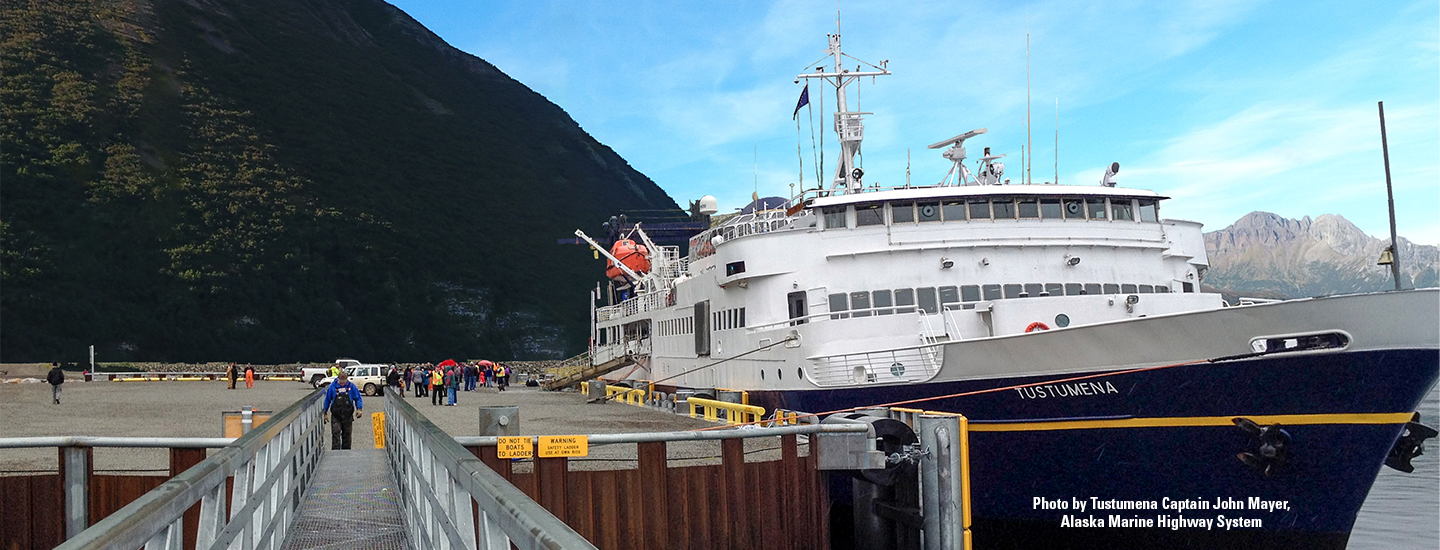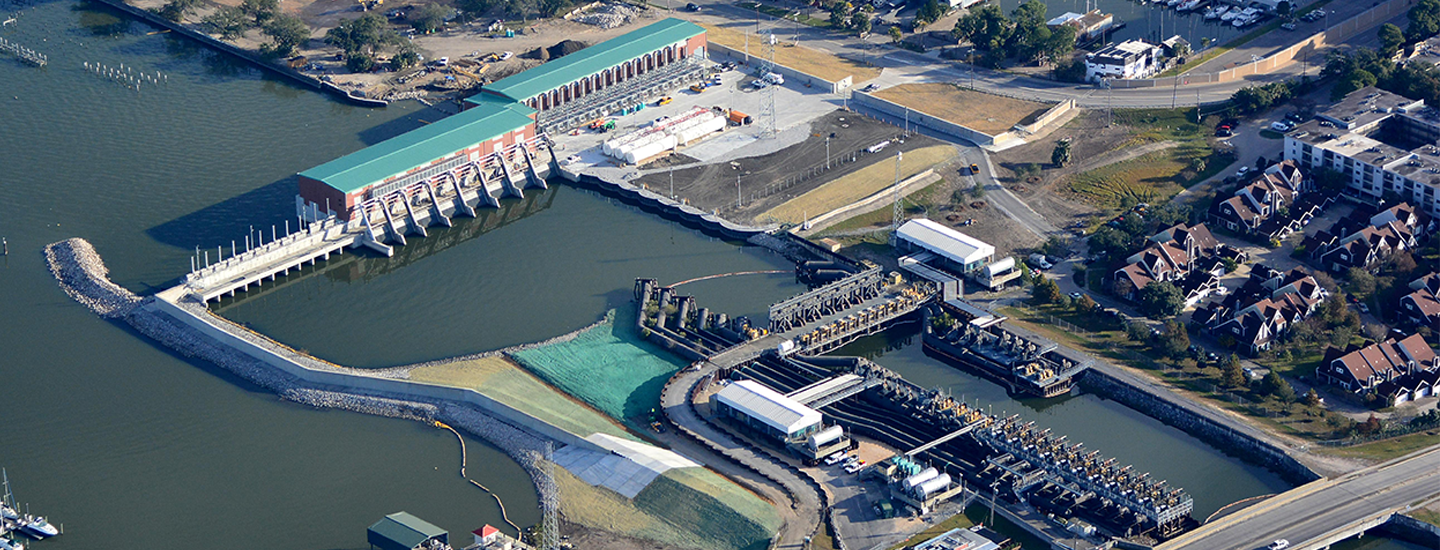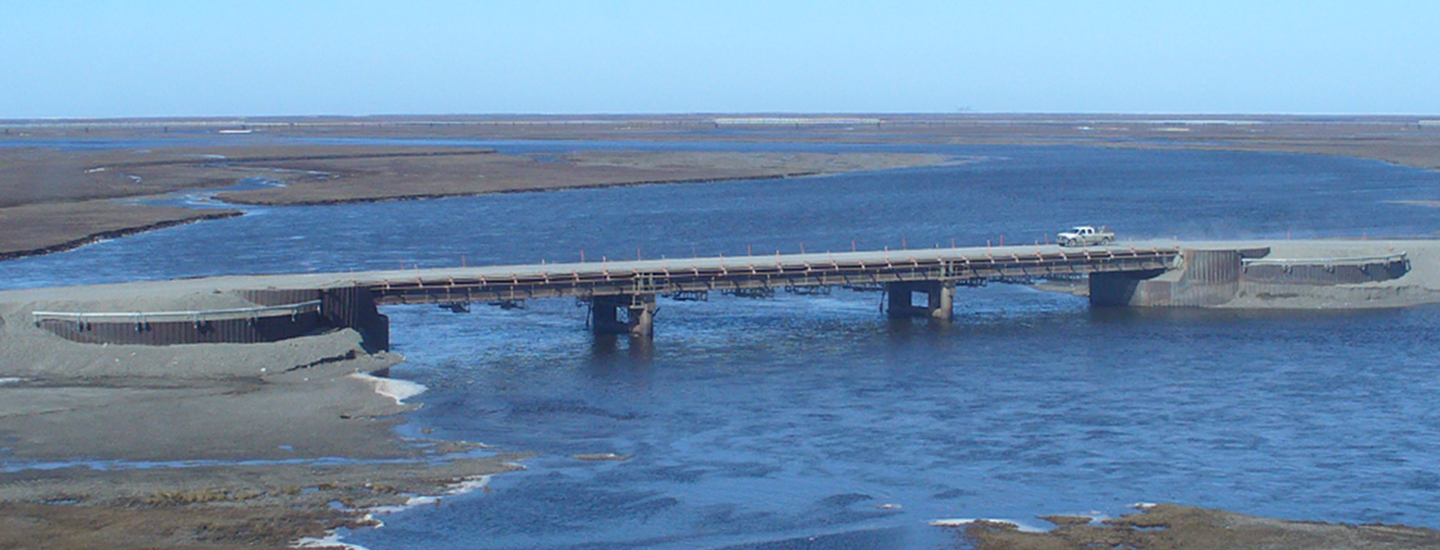OPEN CELL SHEET PILE™
PND first developed our patented and proprietary OPEN CELL SHEET PILE (OCSP™) technology in 1980 after developing the concept for a remote site on the North Slope of Alaska. The award-winning sheet-pile soil-retaining structure features a straightforward design that offers site versatility, low-cost construction, and high-performance installation.
Adaptive Design to Suit the Elements
The OCSP™ design provides cost savings in ordinary conditions, even more so in challenging environments with deep water, shallow bedrock, or soft soils. Its minimal cost stems from its clean design, reduced steel tonnage, simplified construction process, and low maintenance requirements. The system, which retains soil by using vertically arranged pile-driven flat sheet piles, can be used for a variety of civil and structural applications.
The high-tensile capacity of the OPEN CELL™ system can exceed distributed ground loads of 2,500 psf and much higher concentrated loads near the bulkhead face without special reinforcements. Load relief platforms, often needed for other sheet-pile bulkhead systems, are not typically required with the OPEN CELL system.
From bridge abutments to bulkheads, PND has designed more than 250 OCSP systems across the world. PND’s proprietary technology won the prestigious NOVA Award from the Construction Innovation Forum in 1998 for the innovative technology. PND has spent years testing, observing, and refining the OPEN CELL system and holds all related information to be proprietary. The OPEN CELL system is patented, holding patents US 10,024,017 B2; US 10,145,076 B2; and CA 2,714,679.
The OPEN CELL system has survived two direct hits by hurricanes, including a Category 3 hurricane in Bermuda and a Category 5 typhoon in the Philippines.
Withstands Environmental Challenges
Effective project solution for standard to heavy loads in a wide variety of conditions, including high seismic zones, deep soft soils, shallow bedrock, and severe ice.
Easily Modified
Custom design to fit site features and ground conditions, including modifications in the field based on unexpected subsurface conditions.
Simplified Construction
Systematic and repetitive construction process for efficiency; OPEN CELL™ systems can be installed by any skilled construction team using our standardized pile-driving templates.
Stable at Increased Heights
Retains earth heights of up to 75 feet, depending on ground conditions; limited toe embedment required due to vertical tailwall construction.
OPEN CELL™ Technology Uses
Industrial & Commercial Terminals
As vessel sizes increase, ports must expand into deeper water. The OCSP™ structure offers a cost-effective, high-performance alternative for high-capacity loading and unloading facilities, even in the most challenging environmental conditions.
With flexible design, easy modification, and accommodations for long-term settlement, OCSP terminals are a versatile solution for port expansion and modernization. The system can be equipped with a wide variety of mooring and berthing features to support a wide array of vessels.
Waste Isolation Bulkheads for Contaminated Soils
Caring for our communities includes keeping contamination contained and out of sensitive waterways. OPEN CELL™ technology revolutionizes waste isolation bulkheads. As a superior alternative to traditional confined disposal facilities, which use earthen or rock dikes or traditional sheet-pile walls, the vertical OPEN CELL system creates watertight barriers, reducing contaminant transport and maximizing dredged material capacity and beneficial reuse after completion.
The OPEN CELL system has been rigorously tested, including review and endorsement from the U.S. Army Corps of Engineers. It works to eliminate seepage, even in poor soil conditions and deep waters. An award-winning project at Alameda Point kept contaminated soils from leaching into San Francisco Bay, showing the versatility and efficiency of the system.
Bridge Abutments
Protecting connective transportation infrastructure is critical. OCSP™ bridge abutments are a cost-effective solution for small- to medium-sized bridges, offering shortened superstructure lengths, reduced erosion control needs, and smooth hydraulic flow.
The easy construction and ability to support shallow bridge footings—even in weak soils—eliminates the need for long driven support piles. OPEN CELL™ abutments have high load capacity, provide erosion and scour protection, and maintain resistance to extreme weather conditions regardless of the foundation depth.
- Protection Against Scour, Resistance to Extreme Conditions
- Improved Hydrology Through Bridge Opening
- Quick Construction and Long Life
- Adaptable to Site Conditions and Foundation Depth
Man-Made Islands
Man-made islands are used for industrial, commercial, and recreational purposes all over the world. PND has designed multiple OCSP™ islands and land-reclamation structures, with designs incorporating icebreaking structures in the Alaska Arctic and high-performance corrosion protection systems to extend the design life in warmer environments.
OPEN CELL™ technology can be used to create similar islands globally, adaptive to nearly any soil and secure in spite of extreme weather and environmental conditions. PND has also developed a complete offshore island system using its SPIN FIN™ pile technology.
Artificial Levee
The OCSP™ levee is a reduced footprint flood control solution. It rehabilitates aging, deficient levees without encroaching on adjacent property or requiring large amounts of soil fill for improved safety and increased flood capacity.
This solution is being used successfully in post-Katrina New Orleans, Louisiana.
Use OPEN CELL™ Technology for Your Next Project
Build a supremely durable structure in any soil to outlast seismic events and deepwater scour. Contact one of PND's OCSP™ design specialists to discuss your project's specifications, pricing, and potential construction cost savings.
Featured OPEN CELL™ Projects
FAQs
To learn more about PND’s applications of OPEN CELL SHEET PILE™ innovation, read our frequently asked questions.
What is the OPEN CELL SHEET PILE structure?
The OCSP structure is a sheet-pile system used for retaining earth, containment, and shoreline protection. It’s primarily used on docks and similar structures, especially for locations prone to deep water, soft soils, shallow bedrock, high seismic events, and/or severe ice.
What are the advantages of using the OCSP structure?
The OCSP structure provides high load capacity, minimal sheet-pile toe embedment, and can be modified for increased loading or unforeseen ground conditions—natural or otherwise. It also accommodates long-term settlements and comes with cost savings in regular environments, which are magnified in challenging environments.
How does the OCSP structure save costs compared to other systems?
The straightforward design, lower steel tonnages, simplified construction process, and low maintenance requirements are all factors that make the system cost-effective for projects in deep water, shallow bedrock, and/or soft soils. It’s saved project owners more than $150 million in construction costs over other designs.
What types of projects have the OCSP system been used?
PND has designed OCSP systems for projects across the world. The system has been successfully used as abutments for numerous bridges throughout Alaska and the Pacific Northwest, waterfront piers, construction cofferdams, slope protection and erosion control, grade-separation walls, and confined disposal facilities. The technology is versatile for both civil and structural applications.
Has the OCSP™ won any awards or received recognition?
Yes. PND received the prestigious NOVA Award from the Construction Innovation Forum for its OCSP technology in 1998 for its innovative contribution to the construction industry, and we’ve received more than 30 awards for our OCSP projects.
Does PND hold patents for the OCSP system?
Yes. PND has spent years testing, observing, and refining the OCSP system and holds all related information to be proprietary. The OCSP system is patented, holding patents US 10,024,017 B2; US 10,145,076 B2; and CA 2,714,679.
Can the OCSP system be customized for specific project requirements?
Yes. Each OCSP project is specifically designed to site-specific criteria such as soil conditions, environmental loads, surface loading, vessel mooring requirements, available design life requirements, available construction equipment, and project logistics. Each design can be easily modified for site-specific circumstances, providing flexibility and adaptability in a variety of construction projects.
Ready to explore the OPEN CELL™ system?
Achieve your project goals with lower cost construction and higher performance. Contact us to discuss OCSP™ system pricing and benefits to your project.


